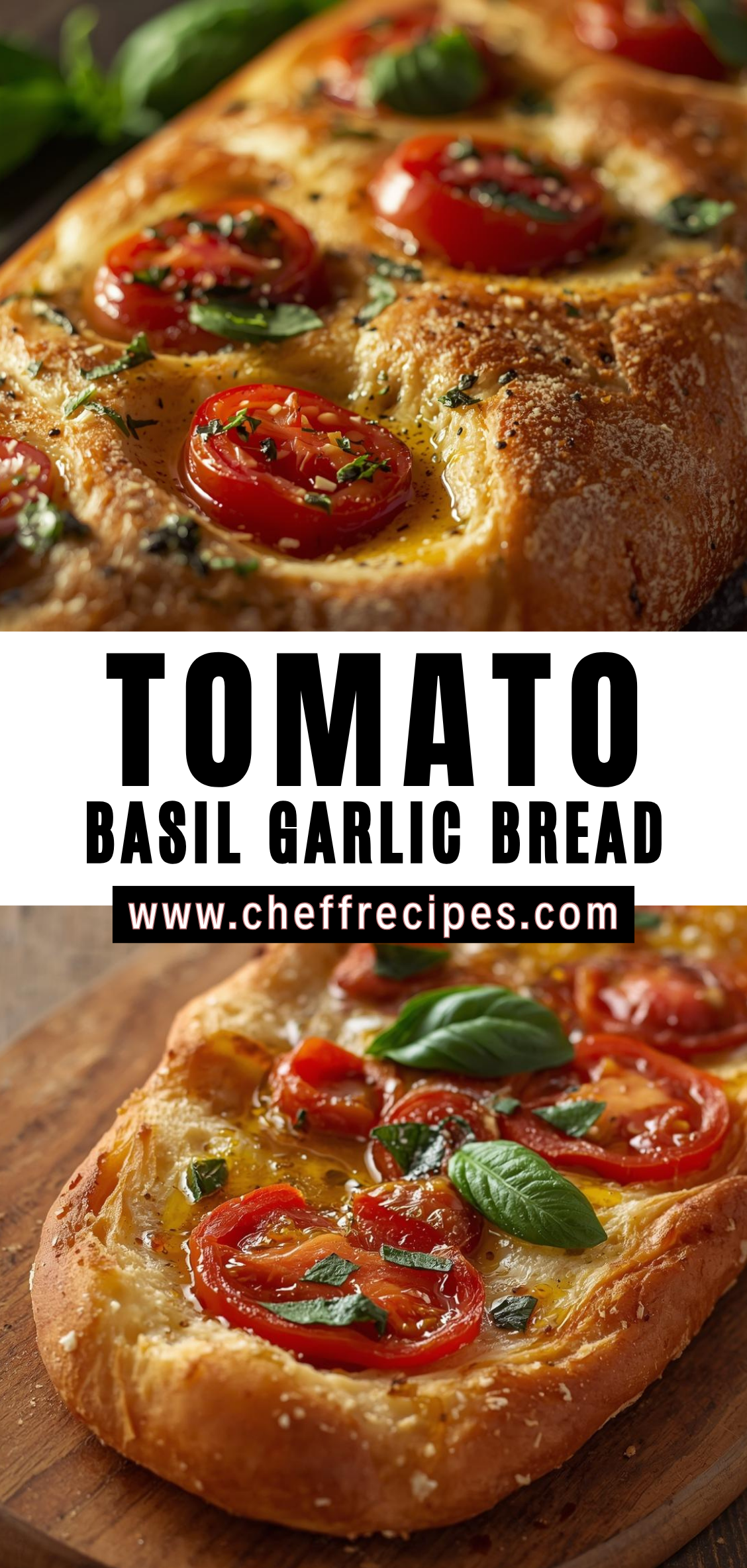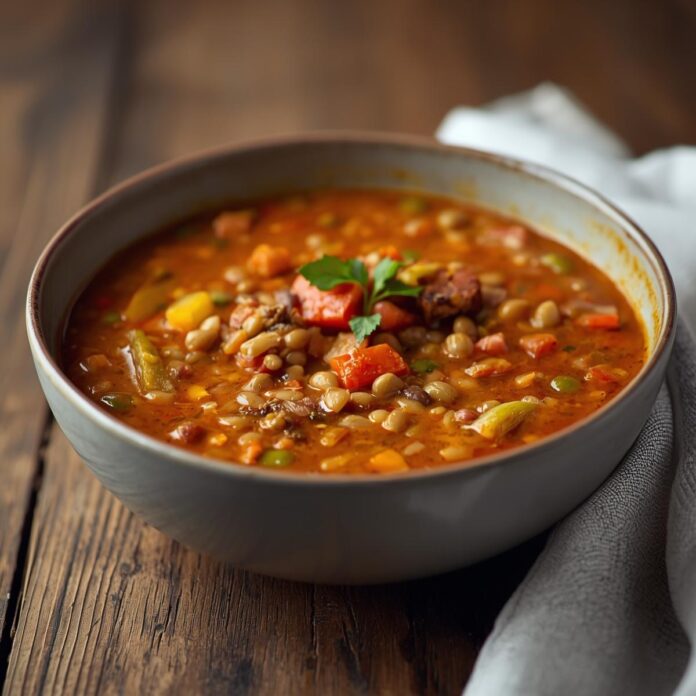Few aromas can rival the intoxicating scent of freshly baked bread wafting through a kitchen — the yeasty warmth of dough, the faintly sweet caramelization of the crust, and the earthy comfort that fills the air. Add to this the unmistakable fragrance of garlic gently roasted in olive oil, the brightness of ripe tomatoes, and the sweet, peppery freshness of basil, and you have something far more than bread. You have Tomato Basil Garlic Bread, a dish that captures the very soul of Mediterranean cooking — rustic, fragrant, and profoundly satisfying.

At its heart, this bread is an homage to simplicity. Each ingredient, humble on its own, transforms when combined: the tomato brings juiciness and acidity; garlic contributes depth and warmth; basil lends its herbaceous freshness; and the bread itself provides a canvas that ties everything together. It is a recipe that relies less on complexity and more on balance — a harmony of flavors achieved through thoughtful preparation and respect for the ingredients.
Tomato Basil Garlic Bread represents more than a side dish. It is a bridge between worlds — between the artisan traditions of breadmaking and the sun-soaked flavors of Italian and Mediterranean cuisines. It can accompany a bowl of soup on a cold evening, stand proudly beside a fresh salad on a summer day, or even serve as the centerpiece of a casual dinner party, its colors vibrant and inviting. Each bite tells a story of warmth and comfort, of kitchens where conversation flows easily and meals are shared with laughter and generosity.
The roots of this dish can be traced to Italy’s agrarian traditions, where bread was revered not just as food but as a symbol of life and community. In the countryside, the day often began with bread — dipped in olive oil, sprinkled with herbs, or topped with sun-ripened tomatoes picked from the garden. It was food made with intention, reflecting the seasons and the landscape. Garlic and basil were not luxuries but staples, grown in small plots near every kitchen. Together, they formed the foundation of countless dishes — from bruschetta and caprese salads to sauces that simmered slowly on the stove. Tomato Basil Garlic Bread is a natural extension of that culinary lineage, born of the desire to combine these quintessential flavors into something both rustic and refined.
But beyond its cultural heritage, there is something deeply emotional about baking bread infused with fresh ingredients. It speaks to a slower rhythm of life — one in which cooking is an act of care, and each step is performed with attention and patience. Kneading the dough becomes a tactile meditation, shaping it a quiet ritual, and the moment the loaf emerges from the oven — golden, fragrant, and crackling — feels almost sacred. In this sense, Tomato Basil Garlic Bread is more than a recipe; it is an experience, one that engages all the senses and connects the cook to a timeless culinary craft.
From a flavor perspective, this bread achieves an exquisite balance of savory, aromatic, and bright. The garlic — roasted, sautéed, or infused into oil — provides a mellow richness that seeps into the dough or coats the crust. The tomatoes contribute a juicy tang that lifts the bread from the ordinary to the extraordinary, while basil adds a fresh, green note that cuts through the richness and leaves a lingering perfume on the palate. When baked, these ingredients fuse into a tapestry of flavors — the bread slightly crisp on the outside, tender within, and speckled with bursts of tomato and hints of herbs. The result is a loaf that feels both hearty and elegant, suitable for casual dining or sophisticated entertaining.
This dish also exemplifies the philosophy of wholesome indulgence. While bread is often viewed as a comfort food, it need not be heavy or guilt-laden. When prepared with fresh, simple ingredients — whole grains, olive oil, herbs, and natural flavors — it becomes not just a pleasure but a nourishing staple. Tomato Basil Garlic Bread offers a satisfying alternative to overly processed options: it is homemade, honest, and full of character. Every slice tells the story of ingredients chosen with care and handled with respect.
The adaptability of this recipe is another of its quiet strengths. It can be prepared as a crusty loaf for slicing, a soft flatbread for sharing, or even as small rolls perfect for appetizers. You can use fresh tomatoes when they are in season, or sun-dried ones in cooler months for a concentrated sweetness. The basil may be stirred into the dough or used as a garnish, while the garlic can be roasted until creamy or minced raw for a sharper bite. Each variation tells a slightly different story, yet all are bound by the same essential truth: the beauty of simplicity.
What makes Tomato Basil Garlic Bread particularly appealing in modern cooking is its fusion of rustic tradition and contemporary versatility. In a world where meals are often rushed, this bread invites us to slow down — to knead by hand, to wait as the dough rises, to savor the transformation that takes place in the oven. Yet it also fits easily into today’s busy kitchens. The recipe can be adapted for quick preparation with pre-made doughs, or elevated into an artisanal version using a slow fermentation process that enhances flavor and texture. Whether baked in a traditional oven, a modern bread machine, or even on a grill, the essence remains unchanged: a bread that celebrates freshness, simplicity, and the joy of sharing good food.
There is also something visually irresistible about this bread. When sliced, it reveals streaks of red and green woven through the golden crumb — a living mosaic of color and texture. It embodies the vibrancy of the Mediterranean table, where food is meant to be seen as much as savored. Placed on a wooden board beside a bowl of olive oil or a dish of balsamic glaze, it becomes a centerpiece of conviviality, inviting hands to reach, dip, and share.
Perhaps the most endearing quality of Tomato Basil Garlic Bread is that it is a recipe of generosity. It is rarely made for one person alone. It is a bread meant to be torn apart, passed around, and enjoyed in the company of others. It brings people to the table — not with grandeur, but with the simple promise of warmth and flavor. There is comfort in knowing that something as modest as a loaf of bread can evoke such feelings of connection and satisfaction.
In the chapters that follow, we will explore this dish in its fullest dimension — beginning with the careful selection of ingredients and moving through each stage of preparation: the art of working the dough, layering the flavors, and achieving the perfect bake. We will examine variations inspired by different culinary traditions, discuss techniques for enhancing both texture and aroma, and even delve into how this bread can fit into a balanced diet.
Ultimately, the goal of this recipe is not only to teach you how to make Tomato Basil Garlic Bread, but also to help you understand why it matters — how a few simple ingredients can transform into something that nourishes both body and spirit. This is not a bread to be rushed, nor one to be eaten without appreciation. It is a bread that tells a story — of sunlight and soil, of kitchens and hands, of patience and pleasure.
And when you finally take that first bite — the crisp crust yielding to soft crumb, the sweetness of tomato blending with the warmth of garlic and the brightness of basil — you will understand that this is more than bread. It is a reminder of everything food can be when made with care: honest, flavorful, and full of life.
Detailed Instructions
1. Gathering and Understanding the Ingredients
Before beginning, it’s essential to understand that this recipe relies on balance. Tomato, basil, and garlic each carry strong personalities — bright, aromatic, and pungent respectively. The key lies in how you layer and mellow those flavors so that they complement, rather than compete with, one another.
Core Ingredients
For the dough:
-
3 cups all-purpose flour (plus extra for dusting)
-
1 teaspoon salt
-
1 teaspoon sugar
-
1 tablespoon olive oil
-
2¼ teaspoons active dry yeast (one standard packet)
-
1 cup warm water (about 105–110°F / 40–43°C)
For the flavor base:
-
2–3 ripe medium tomatoes, finely chopped (or ½ cup sun-dried tomatoes, rehydrated and chopped)
-
3–4 garlic cloves, minced (or roasted garlic for a milder flavor)
-
½ cup fresh basil leaves, chopped or torn
-
1 tablespoon olive oil (plus more for brushing)
-
½ teaspoon black pepper
-
Optional: ¼ teaspoon red pepper flakes for a gentle kick
These proportions yield one medium-sized loaf or about 8–10 generous slices.
2. Preparing the Yeast and Mixing the Dough
Step 1: Activate the Yeast
Start with a clean, dry mixing bowl. Pour in the warm water and stir in the sugar — the sugar will serve as food for the yeast, helping it awaken and multiply. Sprinkle the yeast evenly over the surface of the water. Let it rest for about 5–10 minutes, until it becomes foamy and bubbly.
This foam is the yeast proving that it’s alive and active. If no bubbles form, the yeast may be expired or the water too hot or cold. In that case, discard and start again. A healthy yeast bloom is the foundation of a light, airy bread.
Step 2: Combine the Dry Ingredients
In a large mixing bowl, combine the flour and salt. Mix them with a whisk to distribute the salt evenly. Salt adds flavor but also strengthens the dough’s gluten network. It’s important to keep it separate from the yeast until after activation — too much direct salt contact can inhibit yeast growth.
Step 3: Form the Dough
Pour the activated yeast mixture into the dry ingredients. Add the olive oil. Using a wooden spoon or a dough whisk, stir gently until the dough begins to come together. It will look shaggy and slightly sticky at first. This is normal.
Once the mixture forms a rough mass, transfer it to a lightly floured surface. Begin to knead with clean hands — pressing, folding, and rotating the dough rhythmically. Continue kneading for 8–10 minutes, dusting lightly with flour as needed to prevent sticking but avoiding the temptation to add too much. The goal is a smooth, elastic dough that springs back when gently pressed.
If you’re using a stand mixer, attach the dough hook and mix on medium speed for about 6 minutes, until the dough is supple and cohesive.
3. First Rise: Building Structure and Flavor
Step 4: The First Proof
Lightly oil a clean bowl and place the kneaded dough inside, turning it once to coat it in oil. Cover the bowl with a damp cloth or plastic wrap. Let the dough rise in a warm, draft-free spot for 1 to 1½ hours, or until it has doubled in size.
During this rise, the yeast feeds on the flour’s natural sugars, producing carbon dioxide that expands the dough. This is where structure, texture, and subtle flavor begin to develop.
You can test whether the dough has risen sufficiently by pressing a floured fingertip into it — if the indentation remains, it’s ready.
4. Preparing the Flavor Mixture
Step 5: Creating the Tomato Basil Garlic Base
While the dough rises, prepare the aromatic mixture that will infuse the bread with its signature flavor.
Method:
-
Heat 1 tablespoon of olive oil in a small skillet over medium-low heat.
-
Add the minced garlic and sauté gently for 30–45 seconds, just until fragrant. Be careful not to let it brown, as burnt garlic tastes bitter.
-
Add the chopped tomatoes (fresh or rehydrated sun-dried). Cook for 3–5 minutes, allowing them to soften and release their juices.
-
Remove from heat and stir in the chopped basil, salt, black pepper, and optional red pepper flakes. Let the mixture cool completely.
This base should be rich, aromatic, and slightly thick — not watery. If your tomatoes release excess liquid, simmer gently until the mixture reduces. This prevents the bread from becoming soggy later.
5. Shaping and Incorporating the Flavors
Step 6: Deflating and Rolling
Once the dough has completed its first rise, punch it down gently to release excess gas. Transfer it to a lightly floured surface and roll it out into a rectangle about 12 × 8 inches. The dough should be even in thickness but not too thin; about ¼ inch works well.
Step 7: Layering the Tomato Basil Garlic Mixture
Spread the cooled tomato-basil-garlic mixture evenly over the surface of the dough, leaving about a ½-inch border around the edges. This ensures the filling doesn’t spill out during rolling or baking.
At this stage, your kitchen will already be filled with the mingled aromas of yeast, tomato, and basil — the promise of what’s to come.
Step 8: Rolling and Shaping
You now have two main shaping options:
Option A — Rolled Loaf:
Starting from the long side, roll the dough tightly into a log, pinching the seam closed. Tuck the ends under to form a neat loaf shape.
Option B — Twist Bread:
For a more rustic, artisanal presentation, roll the dough into a log, slice it lengthwise down the middle with a sharp knife, and twist the two strands together with the filling facing outward. This creates a visually striking bread with exposed streaks of tomato and basil.
Transfer the shaped dough to a parchment-lined baking sheet or a greased loaf pan.
6. Second Rise: The Final Proof
Step 9: Letting the Dough Rest Again
Cover the shaped loaf lightly with a kitchen towel and let it rise for 30–40 minutes, or until puffy and nearly doubled in size. This second proof allows the gluten to relax again, ensuring a tender crumb.
During this time, preheat your oven to 375°F (190°C). Place a rack in the center position for even baking.
7. Baking the Bread
Step 10: Applying the Finishing Touch
Before baking, brush the top of the loaf with a thin layer of olive oil. This not only enhances color but also locks in moisture. Optionally, sprinkle with a little coarse sea salt or grated Parmesan for extra flavor.
Step 11: Bake to Perfection
Place the loaf in the preheated oven and bake for 25–30 minutes, or until the crust is golden brown and the bread sounds hollow when tapped on the bottom.
For a slightly crispier crust, you can mist the oven with water just before closing the door — the brief steam helps the bread expand and develop a glossy finish.
If using sun-dried tomatoes or extra basil, check the top halfway through baking; if it starts browning too quickly, cover loosely with foil.
8. Cooling and Serving
Step 12: Resting the Bread
Remove the bread from the oven and transfer it to a wire rack. Allow it to cool for at least 15–20 minutes before slicing. This resting period allows the interior crumb to set properly — slicing too soon can make the bread gummy.
Step 13: Slicing and Enjoying
When you cut into the loaf, you’ll see ribbons of red and green spiraled through the golden crumb. The aroma will be intoxicating — warm garlic mingling with basil and the faint acidity of tomato.
Serve slightly warm or at room temperature. Tomato Basil Garlic Bread pairs beautifully with:
-
A bowl of minestrone or tomato soup
-
Fresh mozzarella or burrata
-
Olive oil and balsamic vinegar for dipping
-
Grilled chicken, pasta, or roasted vegetables
For an indulgent twist, you can toast slices lightly and top with a drizzle of olive oil or a touch of sea salt.
9. Optional Variations
a. Caprese-Style Garlic Bread
Add small cubes of mozzarella between the tomato and basil layers before baking. The cheese melts into creamy pockets that balance the acidity of the tomato.
b. Roasted Garlic and Sun-Dried Tomato Loaf
Use roasted garlic instead of raw, and substitute half the tomatoes with chopped sun-dried ones. The flavor becomes deeper and more caramelized — perfect for cooler months.
c. Whole Wheat Version
Replace half of the all-purpose flour with whole wheat flour. Add 1 tablespoon of honey to balance the nuttier flavor and ensure softness.
d. Vegan Variation
This recipe is naturally vegan if you avoid cheese toppings. Olive oil replaces butter, and no animal products are used.
10. Final Thoughts on Crafting the Perfect Loaf
Tomato Basil Garlic Bread rewards patience and mindfulness. It’s not merely about following steps, but about listening — to the dough as it rises, to the scent that fills the oven, to the crackle as it cools. Each of these small cues tells you something about the process, something that connects you to centuries of bakers who relied on touch and intuition.
This bread teaches restraint — knowing when to stop kneading, when to let the dough rest, when to add flavor without overwhelming. It’s a dialogue between the cook and the ingredients, and when done well, the result is more than the sum of its parts: it’s a loaf that speaks of sun, soil, and hands that work with care.
Tomato Basil Garlic Bread
Few aromas can rival the intoxicating scent of freshly baked bread wafting through a kitchen — the yeasty warmth of dough, the faintly sweet caramelization of the crust, and the earthy comfort that fills the air. Add to this the unmistakable fragrance of garlic gently roasted in olive oil, the brightness of ripe tomatoes, and the sweet, peppery freshness of basil, and you have something far more than bread. You have Tomato Basil Garlic Bread, a dish that captures the very soul of Mediterranean cooking — rustic, fragrant, and profoundly satisfying.
Ingredients
- 1 medium baguette or Italian loaf
- 2 tablespoons olive oil (or melted butter)
- 3 cloves garlic, minced
- 2 medium tomatoes, diced (Roma or cherry tomatoes work best)
- ¼ teaspoon salt
- ¼ teaspoon black pepper
- ¼ teaspoon red pepper flakes (optional, for heat)
- ¼ cup fresh basil leaves, finely chopped
- ¼ cup shredded mozzarella or parmesan cheese (optional, for cheesy version)
Instructions
Notes
- Make it low-calorie: Use less oil or a spray oil and skip the cheese.
- Add protein: Top with sliced grilled chicken or chickpeas before baking.
- Flavor twist: Add a drizzle of balsamic glaze or a sprinkle of oregano for extra flavor.
- Storage: Best enjoyed fresh, but you can store leftovers in an airtight container in the fridge for up to 2 days. Reheat in the oven for best texture.



